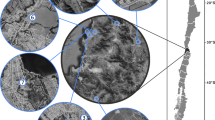Abstract
In this study we have investigated the toxicity of soils from thetwo abandoned pyrite mines Ertelien and Konnerud in the southernpart of Norway. Soil samples were collected close to the pitheadof the mines, and earthworms were exposed to different concentrations of the contaminated mine soil mixed with commercial plant soil for a period of 14 days. Life-cycle responses such as growth and survival, as well as the biomarkerresponse lysosomal fragility were measured. The body burdens ofthe four heavy metals Cu, Cd, Zn and Pb were detected in the worms, and the body concentration of the metals generally increased with increasing heavy metal concentration in the soil.The growth and mortality of the earthworms were not influenced when exposed to any of the mine soil concentrations used. The lysosomal fragility of the earthworm coelomocytes measured by the neutral red retention time (NRR-time) was found to be markedly reduced in all the exposed earthworms. This assay seemsto be a sensitive and dose dependent endpoint for the toxicity assessment of heavy metal mixtures in pyrite mine soils.
Similar content being viewed by others
References
Arnesen, R. T., Esbensen, K. and Grande, M.: 1988, ‘Giftvirkning av tungmetaller fra gruver på fisk. Tungmetallers tilstandsform og biologisk respons’, Norwegian Institute forWater Research, (NIVA), Oslo, Norway, 28 pp.
Bauer-Hilty, A., Dallinger, R. and Berger, B.: 1989, ‘Isolation and partial characterization of a cadmium-binding protein from Lumbricus variegatus (Oligochaeta, Annelida)’, Comp. Biochem. Physiol. 94C, 373–379.
Chvapil, M., Ryan, J. N. and Zukoski, C. F.: 1972, ‘The effect of zinc and other metals on the stability of lysosomes’, Proc. Soc. Exp. Biol. Med. 140, 642–646.
Dallinger, R.: 1993, ‘Strategies of Metal Detoxification in Terrestrial Invertebrates’, in: R. Dallinger and P. S. Rainbow (eds), Ecotoxicology of Metals in Invertebrates, Lewis Press, Chelsea, U.S.A., pp. 245–289.
Dallinger, R.: 1996, ‘Metallothionein research in terrestrial invertebrates: Synopsis and perspectives’, Comp. Biochem. Physiol. 113C, 125–133.
Dallinger, R., Berger, B., Gruber, C., Hunziker, P. and Sturzenbaum, S.: 2000, ‘Metallothioneins in terrestrial invertebrates: structural aspects, biological significance and implications for their use as biomarkers’, Cell Mol Biol. 46, 331–346.
Gupta, S. K.: 2000, ‘Neutral red retention by earthworm coelomocytes: A biomarker of cadmium contamination in soil’, Biomed. Environ. Sci. 13, 117–121.
Harreus, D., Köhler, H.-R. and Weeks, J. M.: 1997, ‘Combined non-invasive cell isolation and neutral red retention assay for measuring the effects of copper on the Lumbricid Aporrectodea rosea (Savigny)’, Bull. Environ. Contam. Toxicol. 59, 44–49.
Ireland, M. P. and Richards, K. S.: 1977, ‘The occurrence and localisation of heavy metals and glycogen in the earthworms Lumbricus rubellus and Dendrobaena rubida from a heavy metal site’, Histochemistry 51, 153–166.
Ireland, M. P.: 1978, ‘Heavy metal binding properties of earthworm chloragosomes’, Acta Biol. Acad. Sci. Hung. 29, 385–394.
Iversen, E. R.: 1990, ‘Vannforurensinger fra nedlagte gruver. Del III’, Norwegian Institute for Water Research (NIVA), Oslo, Norway, 20 pp.
Ma, W., Edelman, T., Van Beersum, I. and Jans, T.: 1983, ‘Uptake of cadmium, zinc, lead and copper by earthworms near a zinc-smelting complex - influence of soil pH and organic matter’, Bull. Environ. Contam. Toxicol. 30, 424–427.
Morgan, A. J. and Morris, B.: 1982, ‘The accumulation and intracellular compartmentation of cadmium, lead, zinc and calcium in two earthworm species (Dendrobaena rubida and Lumbricus rubellus) living in highly contaminated soil’, Histochemistry 75, 269–285.
Morgan, J. E. and Morgan, A. J.: 1989, ‘Zinc sequestration by earthworm (Annelida: Oligochaeta) chloragocyte’, Histochemistry 90, 405–411.
Morgan, J. E., Norey, C. G., Morgan, A. J. and Kay J.: 1989, ‘A comparison of the cadmium-binding proteins isolated from the posterior alimentary canal of the earthworms Dendrodrilus rubidus and Lumbricus Rubellus’, Comp. Biochem. Physiol. 92C, 15–21.
OECD: 1984, Guideline for Testing of Chemicals, No. 207, Earthworms, Acute Toxicity Tests. Organization for Economic Co-operation and development. Paris.
Reinecke, S. A. and Reinecke, A. J.: 1999, ‘Lysosomal response of earthworm coelomocytes induced by long-term experimental exposure to heavy metals’, Pedobiologia 43, 585–593.
Scott-Fordsmand, J. J., Weeks, J. M. and Hopkin, S. P.: 1998, ‘Toxicity of nickel to the earthworm and the applicability of the neutral red retention assay’, Ecotoxicology 7, 291–295.
Scott-Fordsmand, J. J., Weeks, J. M. and Hopkin, S. P.: 2000, ‘Importance of contamination history for understanding toxicity of copper to earthworm Eisenia fetida (Oligochaeta: Annelida), using neutral-red retention assay’, Environ. Tox. Chem. 7, 1774–1780.
Spurgeon, D. J., Hopkin, S. P. and Jones, D. T.: 1994, ‘Effects of cadmium, copper, lead and zinc on growth, reproduction and survival of the earthworm Eisenia fetida (Savigny): Assessing the environmental impact of point-source metal concentration in terrestrial ecosystems’, Environ. Pollut. 84, 123–130.
Spurgeon, D. J., Svendsen, C., Rimmer, V. R., Hopkin, S. P., and Weeks, J. M.: 2000, ‘Relative sensitivity of life-cycle and biomarker responses in four earthworm species exposed to zinc’, Environ. Tox. Chem. 7, 1800–1808.
Sternlieb, I. and Goldfischer, S.: 1976, ‘Heavy metals and lysosomes’, Frontiers in Biology 45, 185–200.
Suzuki, K. T., Yamamura, M. and Mori, T.: 1980, ‘Cadmium-binding proteins induced in the earthworm’, Arch. Environm. Contam. Toxicol. 9, 415–424.
Svendsen, C. and Weeks, J. M.: 1997a, ‘Relevance and applicability of a simple earthworm biomarker of copper exposure. I. Links to ecological effects in a laboratory study with Eisenia andrei’, Ecotox. Environ. Safety 36, 72–79.
Svendsen, C. and Weeks, J. M: 1997b, ‘Relevance and applicability of a simple earthworm biomarker of copper exposure. II. Validation and applicability under field conditions in a mesocosm experiment with Lumbricus rubellus’, Ecotox. Environ. Safety 36, 80–88.
Weeks, J. M. and Svendsen, C.: 1996, ‘Neutral-red retention by lysosomes from earthworm coelomocytes: A simple biomarker for exposure of soil invertebrates’, Environ. Toxicol. Chem. 15, 1801–1805.
Author information
Authors and Affiliations
Corresponding author
Rights and permissions
About this article
Cite this article
Hønsi, T.G., Stubberud, H.E., Andersen, S. et al. Lysosomal Fragility in Earthworms (Eisenia Veneta) Exposed to Heavy Metal Contaminated Soils from Two Abandoned Pyrite Ore Mines in Southern Norway. Water, Air, & Soil Pollution 142, 27–37 (2003). https://doi.org/10.1023/A:1022003809634
Issue Date:
DOI: https://doi.org/10.1023/A:1022003809634




